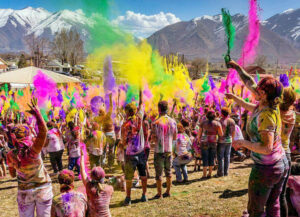 ڦَڳڻُ جو ھي مهينو ﺁﻳﻮ، کڻي مند بهار جي
ڦَڳڻُ جو ھي مهينو ﺁﻳﻮ، کڻي مند بهار جي
ساڻ کڻي هوليءَ جو ڏِڻ، مستيءَ جي پُڪار جي
ڦَڳڻُ جو ھي مهينو ﺁﻳﻮ، کڻي مند بهار جي
The Month of Phaagun has come,
Bringing with it the season of spring,
The Festival of Holi and the call for fun.
Introduction:
Holi, also known as the Festival of Colors, transcends borders and is celebrated worldwide, marking the end of the Sindhi month of Phagun, typically falling between February and March.
Rooted in Indian traditions, this two-day festival of Holi brings people together to revel in joyous moments, including the iconic color play and symbolic bonfires.
Day 1: Holi – A Riot of Colors and Bonfires (هولي):
On the first day, known as Holi, the air is filled with vibrant festivities as people joyfully sprinkle colored water on each other during the day. As night falls, bonfires are lit, and communities gather around the holy Holi Fire to seek blessings for the eradication of both inner and outer evils. This ritual reflects a spiritual cleansing and renewal of commitment to be a better human for the mankind.
Day 2: Dhuriyo – Uniting with Colors and Joy (ڌوڙيو):
The second day, called Dhuriyo, witnesses adults joining with family and friends to partake in playful activities like smearing each other’s faces with colored powder. Children enthusiastically engage in playful encounters with Squirt (پچڪاري) and Water Balloons (ڦوڪڻا). The festival is not just about colors but also about the bonds of love and camaraderie.
Legend of Holi: Prahlad’s Triumph Over Evil:
Holi’s origins trace back to the story of Prahlad, a devout follower of Lord Vishnu. His father, the asura-king Hiranyakashipu, received a unique boon that he would not meet death by an animal or a human; during daytime or at night; caused by weapons, poison or illness; inside or outside his home; and either in air or on ground. This boon seemingly made him invincible though his insatiable lust for power and arrogance eventually led to his downfall.
Since his son Prahlad was a devotee of Lord Vishnu, Hiranyakashipu decided to seek help of his sister Holika (also known as Simhika) to eliminate Prahlad on the pretext of taking the blessings of the Fire God. Prahlad’s devotion to Lord Vishnu protected him and Holika – the sister of Hiranyakashipu – who tried to harm him, met her demise instead.
Eventually, Lord Vishnu appeared as Narasimha (half-man-half-lion) to slay Hiranyakashipu in his lap (neither in air nor on ground) with his claws (not caused by weapons/poison/illness) on the threshold of the demon’s palace (neither inside nor outside) at dusk (neither during the day nor at night).
This tale symbolizes the victory of good over evil through unwavering devotion.
Sindhi Traditions on Holi: A Culinary Celebration:
In addition to the widespread practices, Sindhis have unique customs during Holi. On the second day, daughters and sisters are invited for special lunches or dinners. The celebration is accompanied by the preparation of delectable sweets and delicacies, including Sindhi specialties like Gheehar, Paraghree, Sweet Bread, and Seera Malpura.
Sindhi Holi Specialties:
Holi for Sindhis is incomplete without savoring special dishes such as Gheehar (Sindhi Style Jalebi), Paraghree (Crunchy Layered puff stuffed with Khoya/Mawa), Sweet Bread (مٺي ڍ ٻِل), and Seera Malpura. Traditional Sindhi recipes like Daal Pakwaan, Kadhi Rice, Pulao Patata, and Pakoda add a savory touch to the celebration, creating a delightful culinary experience.
Conclusion:
As we celebrate Holi, let’s embrace the spirit of joy, togetherness, and the triumph of good over evil. Whether playing with vibrant colors, flower petals, or indulging in delicious Sindhi delicacies, the essence of Holi lies in fostering love, unity, and the warmth of shared moments.
SindhiToday.com extends heartfelt wishes for a colorful and joyful Holi to all our readers. May this Festival of Colors bring happiness, love, and the triumph of good over evil to all!
~ Anil Gur (Ulhasnagar, India)

